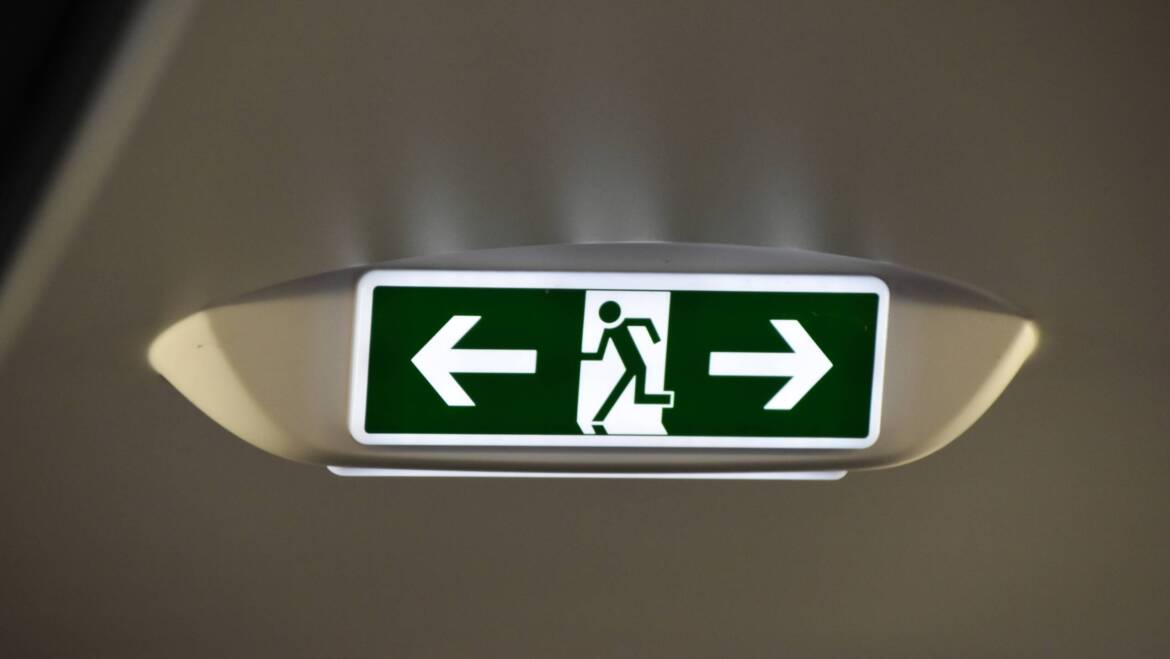Unfortunately, emergency lighting systems are usually completely neglected or undertaken by another electrical trade to install and maintain.
This is not meant in any way to undermine the workmanship or skills that other trades have but many skilled people do not understand the complexity of emergency lighting.
Emergency lights require a specialised service (BS 5266). This includes:
- The emergency light is the correct construction to suit the environment ….(water-resistant or directional).
- A battery load check to verify they will stay illuminated for the correct amount of time.
- The correct amount of lights to give a safe means of escape from the building ….(external exit lights are often overlooked).
- The tube is lighting correctly and the correct type.
- The date the battery was manufactured (batteries require changing every four years).
- The signage is of the correct standard to prevent contravention of the Signs & Signals Act.
- Training staff on the required monthly testing as required by the latest regulations.
- The correct switching is in place to allow the staff to undertake the tests.
- Certification to verify the emergency lights have been passed their service inspection.
- A location report detailing the location of the unit with the age and type of batteries.
- Stocking specialised batteries required to maintain emergency lighting systems.
NFASS offers a service to maintain our customer’s emergency lights during the second (minor) fire alarm test. This has been a very popular method to reduce servicing costs and ensures our customers follow the governmental guidelines with the minimum disturbance within their workplace.
BS 5266-1
BS 5266-1 is the first in a series of Codes of practice on emergency lighting. It gives detailed guidance on the application and practice of emergency escape lighting, with a view to ensuring safety in the event that normal lighting is interrupted. The recommendations have been drawn up to encourage uniformity of application.
Further Reading
12 Servicing
12.1 Supervision
Regular servicing is essential. The occupier/owner of the premises should appoint a competent person to supervise the system. This person should be given sufficient authority to ensure the carrying out of any work necessary to maintain the system in correct operation.
12.2 Batteries
In all cases the manufacturer’s instructions should be followed. It is particularly important that where applicable:
a) the tops of batteries and their terminals are kept clean and unobstructed and that battery cases are periodically checked for leaks;
b) the electrolyte is at all times kept at the correct level as recommended by the manufacturer;
c) any replacement battery should be compatible with the battery charger;
d) any replacement cell should be compatible with the battery;
e) any replacement battery charger should be compatible with the battery.
12.3 Generators
The manufacturer’s instructions as given in the associated instruction manual or other literature should always be followed. It should be noted, however, that the failure of engines to start up readily often arises from poor maintenance or defects in the starting battery or in electromechanical apparatus, e.g. relays Incorporated in the starting system.
Dust and damp, singly or in combination, can have an adverse effect on electromechanical apparatus and it is therefore important that a system of regular cleaning and, where necessary, adjustment is carried out. Some parts of the starting system may be sited where they are subject to vibration and great care should therefore be taken in such instances to ensure that all connections are mechanically and electrically sound. It is essential that air intakes and exhausts are unobstructed.
12.4 Routine inspections and tests
12.4.1 General
Because of the possibility of a failure of the normal lighting supply occurring shortly after a period of testing of the emergency lighting system or during the subsequent recharge period, all tests should wherever possible be undertaken at time of minimum risk.
Alternatively, suitable temporary arrangements should be made until the batteries have been recharged. Inspections and tests should be carried out at the following intervals as recommended in 12.4.2 to 12.4.6;
a) daily;
b) monthly;
c) six-monthly;
d) three-yearly;
e) subsequent annual test.
12.4.2 Daily
An inspection should be made every day to ascertain that:
a) any fault recorded in the log book has been given urgent attention and the action noted;
b) every lamp in a maintained system is lit;
c) the main control or indicating panel of each central battery system or engine driven generator plant indicates normal operation;
d) any fault found is recorded in the log book and the action taken noted.
12.4.3 Monthly
An inspection should be made at monthly intervals in accordance with a systematic schedule. A model schedule is illustrated in annex D.
Tests should be carried out as follows.
a) Each self-contained luminaire and internally illuminated exit sign should be energized from its battery by simulation of a failure of the supply to the normal lighting for a period sufficient only to ensure that each lamp is illuminated. The period of simulated failure should not exceed
one quarter of the rated duration of the lurninaire or sign.
During this period all luminaires andlor signs should be examined visually to ensure that they are functioning correctly. At the end of this test period the supply to the normal lighting should be restored and any indicator lamp or device checked to ensure that it is showing that the normal supply has beenrestored.
b) Each central battery system should be energized from its battery by simulation of a failure of the supply to the normal lighting for a period sufficient only to ensure that each lamp is illuminated. The period of simulated failure should not exceed one quarter of the rated duration of the battery. During this period all luminaires and/or signs should be examined visually to ensure that they are functioning correctly.
If it is not possible to examine visually all luminaires andlor signs in this period, further tests should be made after the battery has been fully recharged. At the end of each test period the supply to the normal lighting should be restored and any indicator lamp or device checked to ensure that it is showing that the normal supply has been restored. The charging arrangements should be
checked for proper functioning.
c) Each engine-driven generating plant should be started up by a simulation of a failure of the supply to the normal lighting and allowed to energize the emergency lighting system for a continuous period of at least 1 h. During this time all luminaires and/or signs should be examined visually to ensure that they are functioning correctly.
At the end of the test period the system should be restored to normal operation and the charging arrangements for the engine-starting battery checked for proper functioning. The fuel tanks should be left filled and the oil and coolant levels topped up as necessary.
Frequent starting of the plant followed by a few minutes on load is not recommended.
d) The engine of each engine-driven generating plant with back-up batteries should be prevented from starting. The emergency lighting system should then be energized solely from the back-up battery by simulation of a failure of the supply to the normal lighting for a period sufficient only to ensure that the change-over from normal supply to battery is a functioning properly. After this check the starting system of the engine should be returned to nonnal operation and the engine allowed to start up in the normal way to energize the emergency lighting system for a continuous period of at least 1h.
During these periods all luminaires and/or signs should be examined visually to ensure that they are functioning correctly. At the end of the test period the system should be restored to normal operation and the charging arrangements for the back-up and the engine- starting batteries checked for proper functioning. The fuel tanks should be left filled and the oil and coolant levels topped up as necessary.
12.4.4 Six-monthly
The monthly inspection (see 12.4.3) should be carried out and the following tests made.
a) Each 3h self-contained luminaire and internally illuminated sign should be energized from its battery for a continuous period of 1 h, by simulation of a failure of the supply to the normal lighting. If the luminaire is rated as having a duration of 1h, then the period of simulated failure should be 15 min. During this period all luminaires andlor signs should be examined visually to ensure that they are functioning correctly.
At the end of this test period the supply to the normal lighting should be restored and any indicator lamp or device checked to ensure that it is showing that the normal supply has been restored.
b) Each 3h central battery system should be energized from its battery for a continuous period of 1 h by simulation of a failure of the supply to the normal lighting. If the system is rated as having a duration of 1 h then the period of simulated failure should be 15 min.
During this period all luminaires andlor signs should be examined visually to ensure that they are functioning correctly. At the end of the test period the supply to the normal lighting should be restored and any indicator lamp or device checked to ensure that it is showing that normal supply has been restored. The charging arrangements should be checked for proper functioning.
c) Each engine-driven plant should be tested in accordance with the monthly schedule detailed in 12.4.3.
d) The engine of each engine-driven generating plant with back-up battery should be prevented from starting. The emergency lighting system should then be energized solely from the back-up battery for a continuous period of 1 h by simulation of failure of the supply to the normal lighting.
The starting system of the engine should then be restored to normal operation and the engine allowed to start up in the normal way to energize the emergency lighting system for a further continuous period of 1 h. During these periods all luminaires andor signs should be examined visually to ensure that they are functioning correctly. At the end of the test period the system should be restored to normal operation and the charging arrangements for the back-up and engine-starting batteries checked for proper functioning. Any indicator lamp or device should then be checked to ensure that it is showing that the normal arrangements have been restored. The fuel tanks should be left filled and the oil and the coolant levels topped up as necessary.
12.4.5 Three-yearly
The monthly inspection (see 12.4.3) should be carried out and the following additional tests made.
a) Each emergency lighting installation should be tested and inspected to ascertain compliance with this code (see annex C).
b) Each self-contained luminaire andor internally illuminated sign should be tested for its full duration. At the end of the test period the supply to the normal lighting should be restored and any indicator lamp or device checked to ensure that it is showing that normal supply has been restored.
c) Each central battery system should be tested for its full duration. At the end of the test period the supply to the normal lighting should be restored and any indicator lamp or device checked to ensure that it is showing that normal supply has been restored. The charging arrangements should be checked for proper functioning.
d) Each generator back-up battery, where fitted, should be tested for its full duration.
At the end of the test period the system should be restored to normal operation and the charging arrangements for the back-up and engine-starting batteries checked for proper functioning. Any indicator lamp or device should then be checked to ensure that it is showing that normal arrangements have been restored. The fuel tanks should be left filled and the oil and coolant levels topped up as necessary.
12.4.6 Subsequent annual test
For self-contained luminaires with sealed batteries, after the first three-yearly test the three-yearly test should be carried out annually.
Back to our list of services

